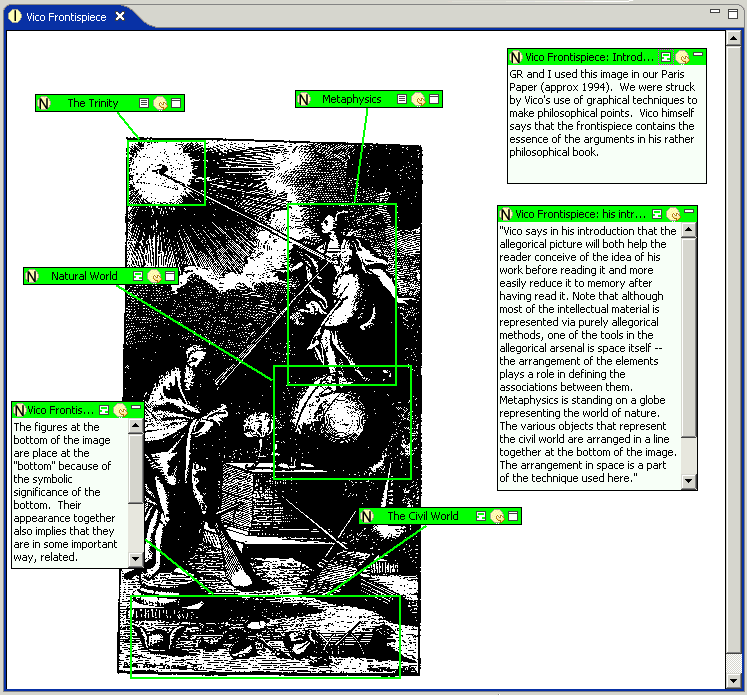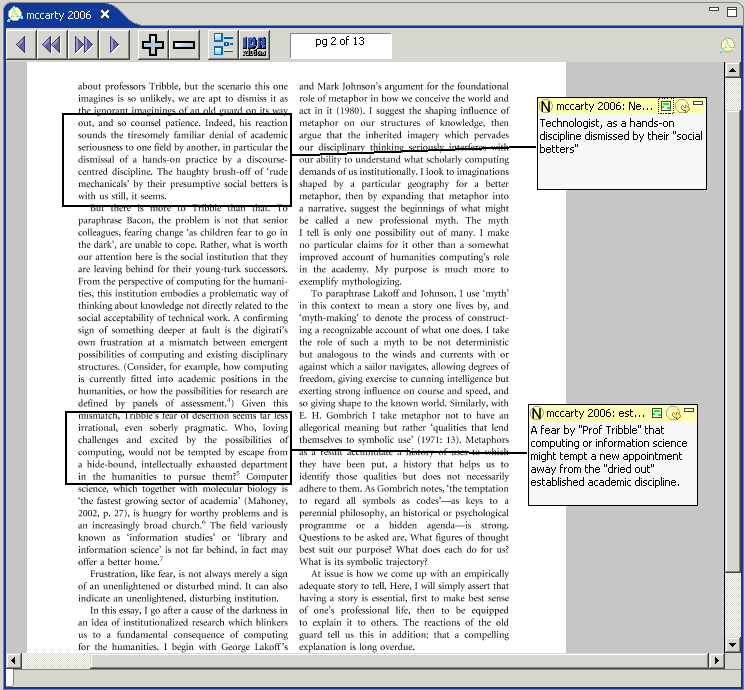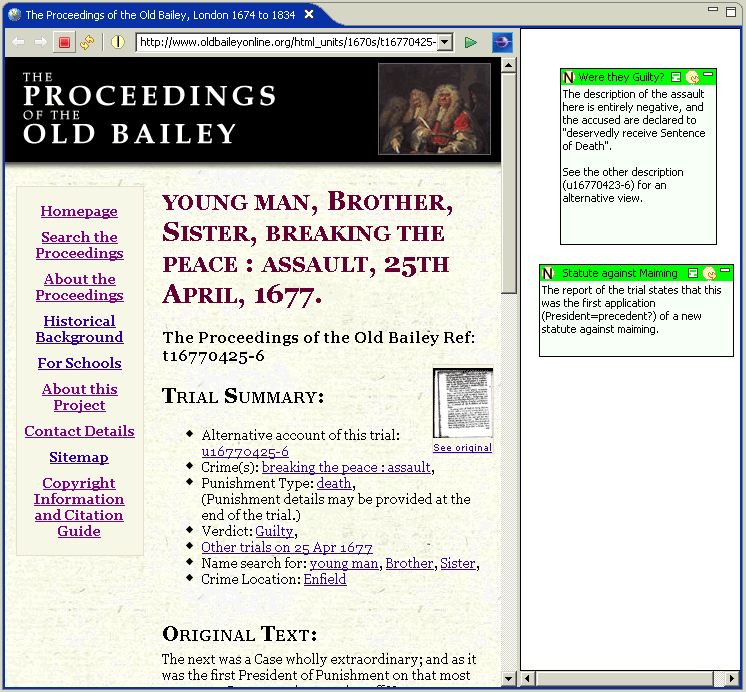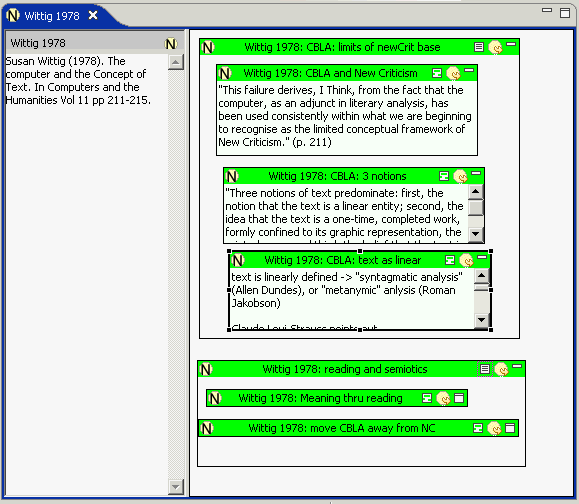 |
 |
4. Screenshots
Here are a few screen shots of Pliny to show you Pliny in Action. We start with a screen showing a user working with an image in Pliny; in this case the frontispiece of Vico's New Science:

Annotations of various kinds have been attached to the image. Some of them ("The Trinity", "Metaphysics", etc.) are shown "closed" because they here represent concepts of interest to the Pliny user, and the annotator has decided that no further comment was necessary here. Others ("Vico Frontispiece: Introduction", for example) contain some extended text as a part of their contents, and the user has chosen to show this textual content here as well.
Pliny also allows you to annotate PDF (Acrobat) files in the same sort of way. Here is a screen showing a page from Willard McCarty's recent article in the journal Literary and Linguistic Computing "Tree, Turf, Centre, Archipelago -- or Wild Acre?" in LLC Vol. 21 No. 1, with two annotations added by the Pliny user:

Each time the user who has attached these annotations to the image or the page of the PDF file revisits these pages these annotations will appear, and more annotations can be added, or old ones removed or altered on subsequent visits.
Pliny can also be used to attach annotations to web pages:

Here the Pliny user has visited the Old Bailey website (http://www.oldbaileyonline.org/), and found there a report of a trial that was of interest. S/he has recorded two notes about the trial and its report. Again, each time s/he revisits the webpage in Pliny s/he will see the annotations she added previously and can create new ones, or edit the old ones if s/he wishes.
Pliny can also be useful for recording notes about non-digital materials. The following example shows a set of notes collected by the Pliny reader when s/he read Susan Wittig's 1978 article that appeared in Computers and the Humanities, "The Computer and the Concept of Text" (Vol 11. pp. 211-215):

Here, the Pliny user has begun to use the grouping facilities provided by Pliny to begin the process of taking the notes s/he recorded during his/her reading and organising them into an interpretative structure. Of interest to the Pliny user was two of Wittig's themes: first, the limits imposed by the New Criticism base that provided the foundation for existing text analysis tools at the time, and second, the relationship between reading and semiotics. Three notes that our user made when reading Wittig related to the New Criticism theme, and the Pliny user has made this theme into a container called "CBLA: limits of newCrit base" and placed the three relevant notes in it.. The two notes (both shown without their contents here) are put inside the other theme container "reading and semiotics".
In the last example we have seen Pliny being used to organise notes that arose from the reading of a single article. The same mechanisms can be used to allow the user to begin to use the notes s/he recorded during reading into a larger interpretative structure. In this next figure a set of notes related to the use of 2D space for study have been brought together into a thematic note, and then organised into a conceptual structure that is of interest to the Pliny user:

For the theme "uses of space for study" the Pliny user has grouped notes that refer to examples taken from his/her reading (shown in orange) and grouped them into two kinds of uses of space categories: "Cartesian" and "topological". S/he has added a commentary note in the upper right corner, and noted that the "Visualisation" category is a related topic. The colours attached to the note displays are being used by the Pliny user to indicate the kind of relationship each note has to the host note "Uses of Space for Study". Here, the cream coloured items provide commentary on the subject, the purple headed notes indicate that they are kinds of uses, the orange indicate examples, and the pink indicates a related topic.
Containment is one of the organising principles available to Pliny users, and Pliny provides a containment view to help users understand the containment structures they are building. Here is a part of the containment view that comes from examining containment relationships around the theme "uses of space for study":

The entire containment figure does not fit here, but we can see different notes in the display with arrows showing the containment -- for example, the two arrows pointing to our note "uses of space for study" show that a reference to it appears in two other notes "Strategies for managing notes" and "Pliny: What's it for?". Furthermore, although the uses of space for study display doesn't show it directly, one of the objects it contains ("Cartesian use of space") is also referenced on the note called "West Wycombe Materials-a".
Pliny also provides a word searching mechanism so that we can quickly find all notes that contain a word or phrase. This is particularly useful when you have a large number of notes, and you cannot remember where a particular topic was referenced.

The result of three steps is shown here. First, the user opened the "Note Search View" panel (shown above to the left, and typed in the word "sociological" (you can see it still in the little text box near the top left corner of the figure). Pliny located the word in 6 notes, and shows you the list of notes it found below the box where the user had typed in "Sociological": "Snyder: Note 6", "Zwerman: Note 2", etc. From there the Pliny user can click on any or all notes to see their contents displayed in Pliny's main panel to the right. Instead, however, the user requested that Pliny create a new note containing a reference to all these notes. Pliny has done this and now displays it (entitled "Query Selection: sociological") in the main frame. The created note contains a reference to each note Pliny found that contained the word "sociological". From there, the user has begun to take the note references and use the 2D space Pliny provides to organise them.
There are other facilities that Pliny provides to help you organise notes, and I hope to add even more. I hope this sampling of screens with commentary has given you a sense of what Pliny is for.
John Bradley
Center for Computing in the Humanities
King's College London